Work Motivation: Wesfarmers Limited Australia
VerifiedAdded on 2023/06/13
|7
|1199
|176
AI Summary
This article discusses the major theories of work motivation such as Expectancy Theory, Hawthorne Effect, Maslow’s Hierarchy of Needs, Hertzberg’s Two-Factor Theory, and Three-dimensional Theory of Attribution. It also explores how Wesfarmers Limited Australia has implemented these theories to develop their organizational behavior.
Contribute Materials
Your contribution can guide someone’s learning journey. Share your
documents today.
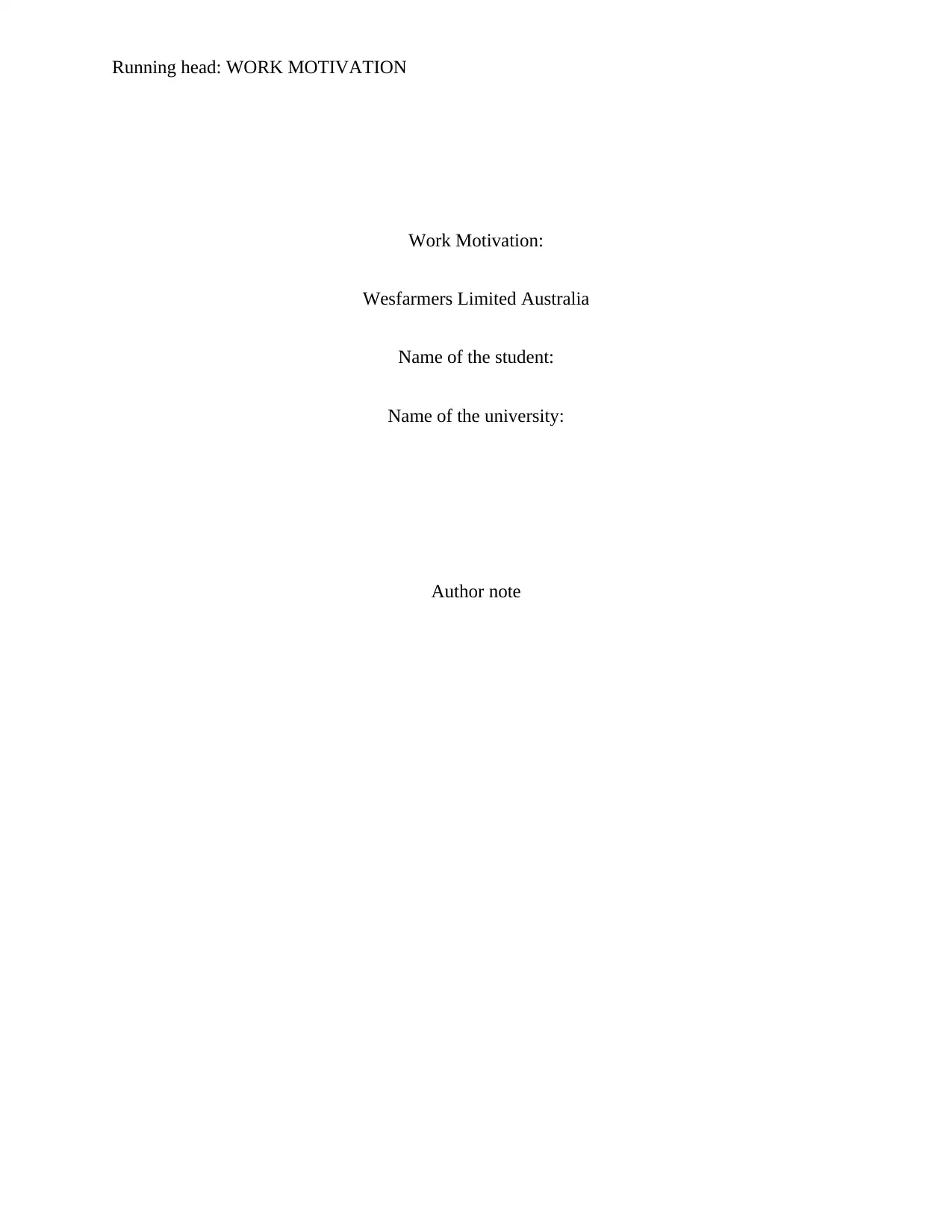
Running head: WORK MOTIVATION
Work Motivation:
Wesfarmers Limited Australia
Name of the student:
Name of the university:
Author note
Work Motivation:
Wesfarmers Limited Australia
Name of the student:
Name of the university:
Author note
Secure Best Marks with AI Grader
Need help grading? Try our AI Grader for instant feedback on your assignments.
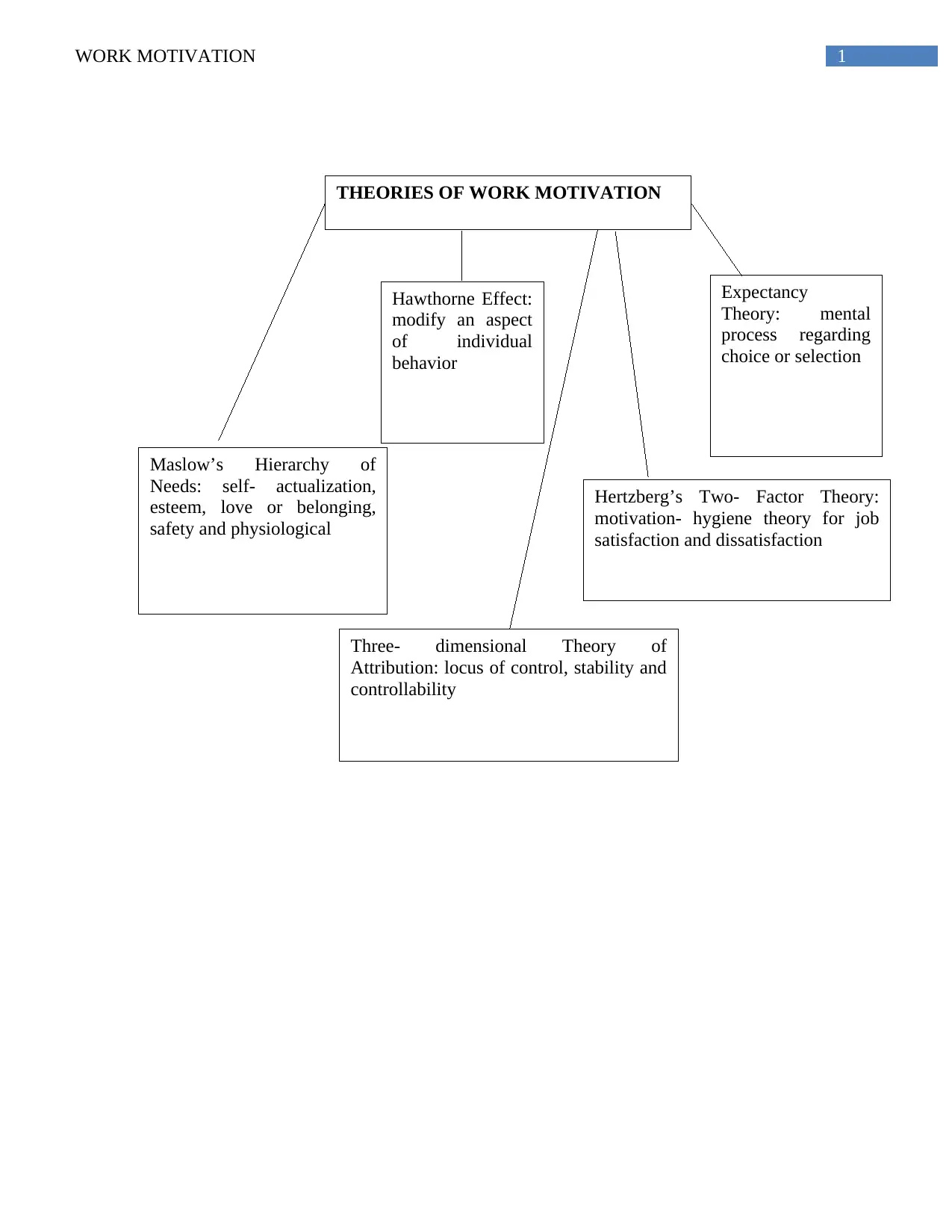
1WORK MOTIVATION
THEORIES OF WORK MOTIVATION
Hertzberg’s Two- Factor Theory:
motivation- hygiene theory for job
satisfaction and dissatisfaction
Maslow’s Hierarchy of
Needs: self- actualization,
esteem, love or belonging,
safety and physiological
Hawthorne Effect:
modify an aspect
of individual
behavior
Expectancy
Theory: mental
process regarding
choice or selection
Three- dimensional Theory of
Attribution: locus of control, stability and
controllability
THEORIES OF WORK MOTIVATION
Hertzberg’s Two- Factor Theory:
motivation- hygiene theory for job
satisfaction and dissatisfaction
Maslow’s Hierarchy of
Needs: self- actualization,
esteem, love or belonging,
safety and physiological
Hawthorne Effect:
modify an aspect
of individual
behavior
Expectancy
Theory: mental
process regarding
choice or selection
Three- dimensional Theory of
Attribution: locus of control, stability and
controllability
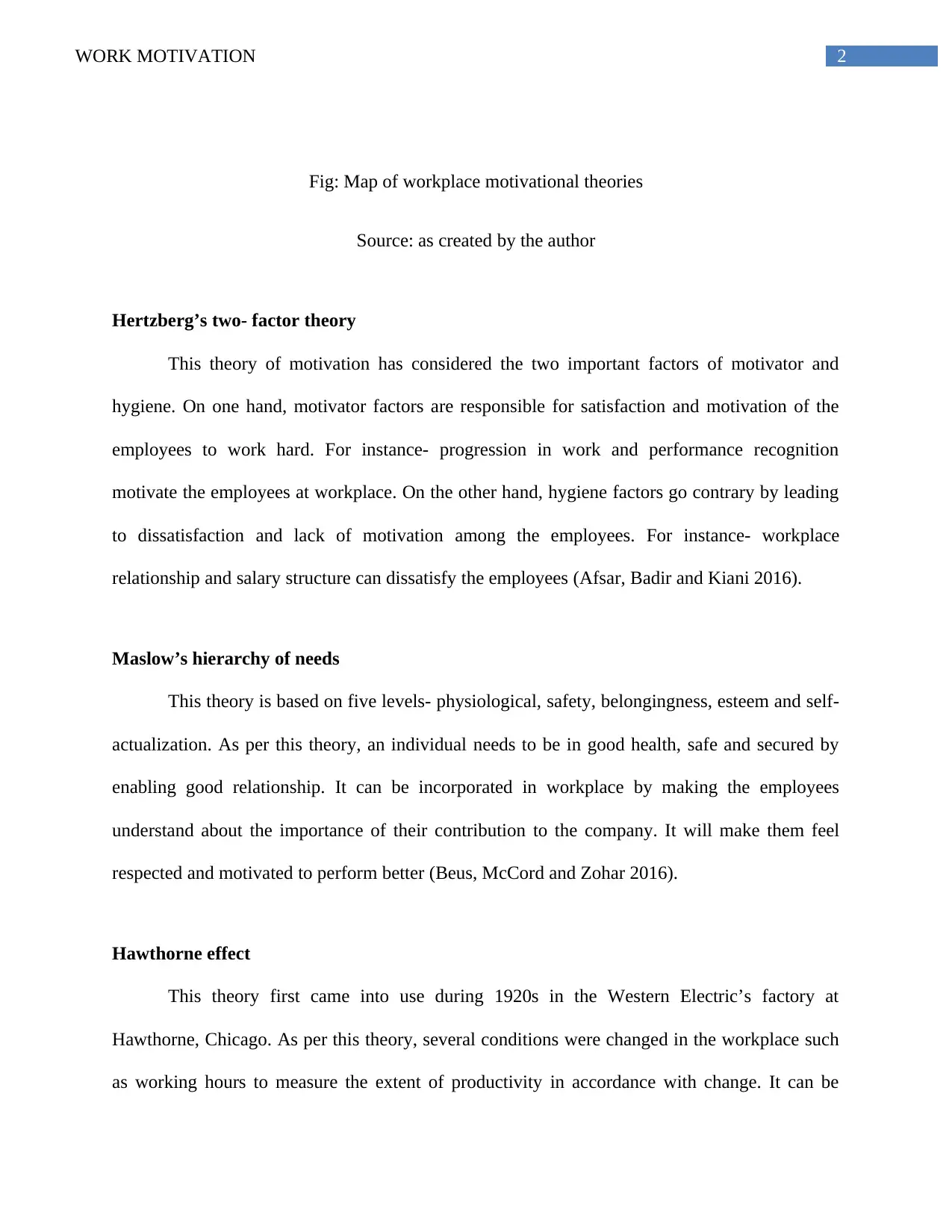
2WORK MOTIVATION
Fig: Map of workplace motivational theories
Source: as created by the author
Hertzberg’s two- factor theory
This theory of motivation has considered the two important factors of motivator and
hygiene. On one hand, motivator factors are responsible for satisfaction and motivation of the
employees to work hard. For instance- progression in work and performance recognition
motivate the employees at workplace. On the other hand, hygiene factors go contrary by leading
to dissatisfaction and lack of motivation among the employees. For instance- workplace
relationship and salary structure can dissatisfy the employees (Afsar, Badir and Kiani 2016).
Maslow’s hierarchy of needs
This theory is based on five levels- physiological, safety, belongingness, esteem and self-
actualization. As per this theory, an individual needs to be in good health, safe and secured by
enabling good relationship. It can be incorporated in workplace by making the employees
understand about the importance of their contribution to the company. It will make them feel
respected and motivated to perform better (Beus, McCord and Zohar 2016).
Hawthorne effect
This theory first came into use during 1920s in the Western Electric’s factory at
Hawthorne, Chicago. As per this theory, several conditions were changed in the workplace such
as working hours to measure the extent of productivity in accordance with change. It can be
Fig: Map of workplace motivational theories
Source: as created by the author
Hertzberg’s two- factor theory
This theory of motivation has considered the two important factors of motivator and
hygiene. On one hand, motivator factors are responsible for satisfaction and motivation of the
employees to work hard. For instance- progression in work and performance recognition
motivate the employees at workplace. On the other hand, hygiene factors go contrary by leading
to dissatisfaction and lack of motivation among the employees. For instance- workplace
relationship and salary structure can dissatisfy the employees (Afsar, Badir and Kiani 2016).
Maslow’s hierarchy of needs
This theory is based on five levels- physiological, safety, belongingness, esteem and self-
actualization. As per this theory, an individual needs to be in good health, safe and secured by
enabling good relationship. It can be incorporated in workplace by making the employees
understand about the importance of their contribution to the company. It will make them feel
respected and motivated to perform better (Beus, McCord and Zohar 2016).
Hawthorne effect
This theory first came into use during 1920s in the Western Electric’s factory at
Hawthorne, Chicago. As per this theory, several conditions were changed in the workplace such
as working hours to measure the extent of productivity in accordance with change. It can be
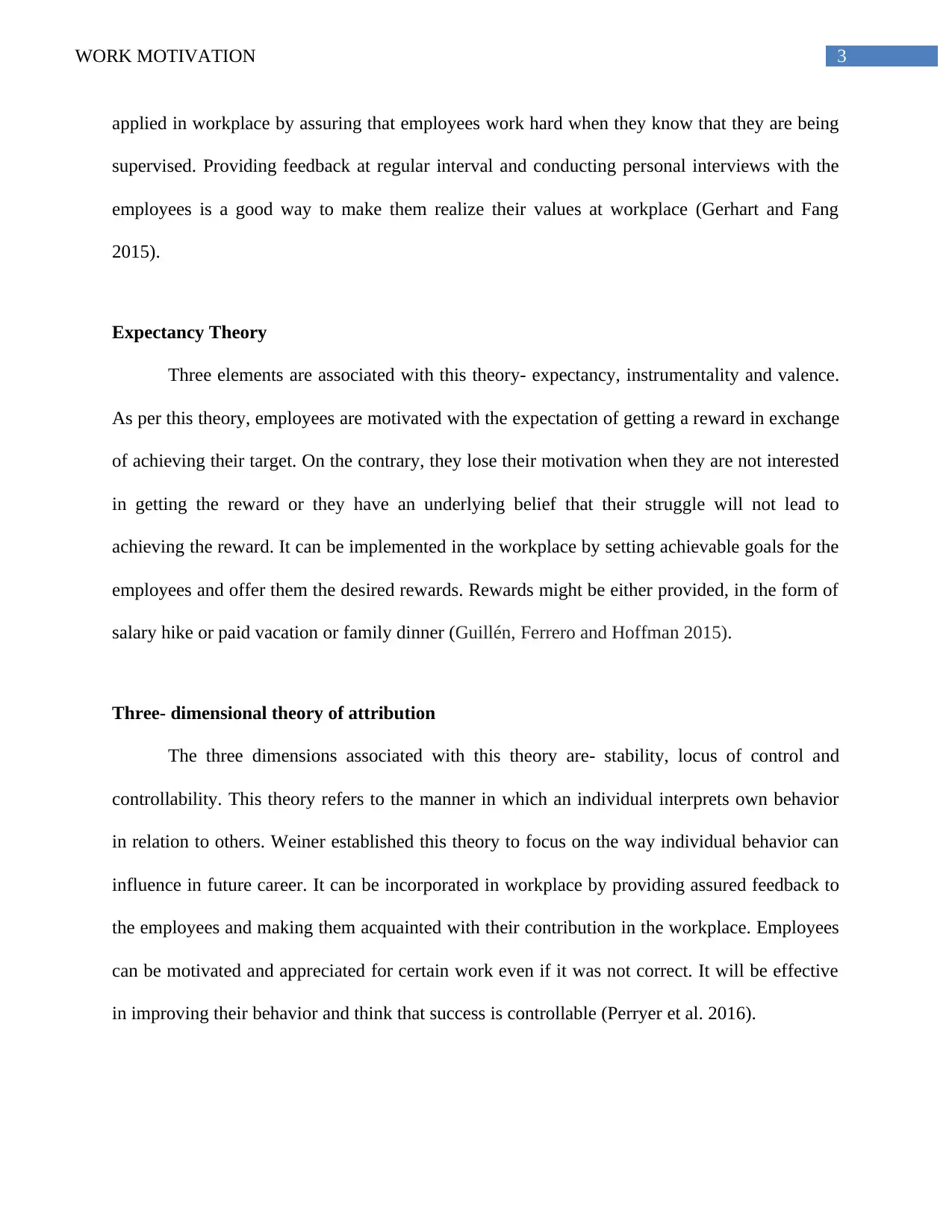
3WORK MOTIVATION
applied in workplace by assuring that employees work hard when they know that they are being
supervised. Providing feedback at regular interval and conducting personal interviews with the
employees is a good way to make them realize their values at workplace (Gerhart and Fang
2015).
Expectancy Theory
Three elements are associated with this theory- expectancy, instrumentality and valence.
As per this theory, employees are motivated with the expectation of getting a reward in exchange
of achieving their target. On the contrary, they lose their motivation when they are not interested
in getting the reward or they have an underlying belief that their struggle will not lead to
achieving the reward. It can be implemented in the workplace by setting achievable goals for the
employees and offer them the desired rewards. Rewards might be either provided, in the form of
salary hike or paid vacation or family dinner (Guillén, Ferrero and Hoffman 2015).
Three- dimensional theory of attribution
The three dimensions associated with this theory are- stability, locus of control and
controllability. This theory refers to the manner in which an individual interprets own behavior
in relation to others. Weiner established this theory to focus on the way individual behavior can
influence in future career. It can be incorporated in workplace by providing assured feedback to
the employees and making them acquainted with their contribution in the workplace. Employees
can be motivated and appreciated for certain work even if it was not correct. It will be effective
in improving their behavior and think that success is controllable (Perryer et al. 2016).
applied in workplace by assuring that employees work hard when they know that they are being
supervised. Providing feedback at regular interval and conducting personal interviews with the
employees is a good way to make them realize their values at workplace (Gerhart and Fang
2015).
Expectancy Theory
Three elements are associated with this theory- expectancy, instrumentality and valence.
As per this theory, employees are motivated with the expectation of getting a reward in exchange
of achieving their target. On the contrary, they lose their motivation when they are not interested
in getting the reward or they have an underlying belief that their struggle will not lead to
achieving the reward. It can be implemented in the workplace by setting achievable goals for the
employees and offer them the desired rewards. Rewards might be either provided, in the form of
salary hike or paid vacation or family dinner (Guillén, Ferrero and Hoffman 2015).
Three- dimensional theory of attribution
The three dimensions associated with this theory are- stability, locus of control and
controllability. This theory refers to the manner in which an individual interprets own behavior
in relation to others. Weiner established this theory to focus on the way individual behavior can
influence in future career. It can be incorporated in workplace by providing assured feedback to
the employees and making them acquainted with their contribution in the workplace. Employees
can be motivated and appreciated for certain work even if it was not correct. It will be effective
in improving their behavior and think that success is controllable (Perryer et al. 2016).
Secure Best Marks with AI Grader
Need help grading? Try our AI Grader for instant feedback on your assignments.
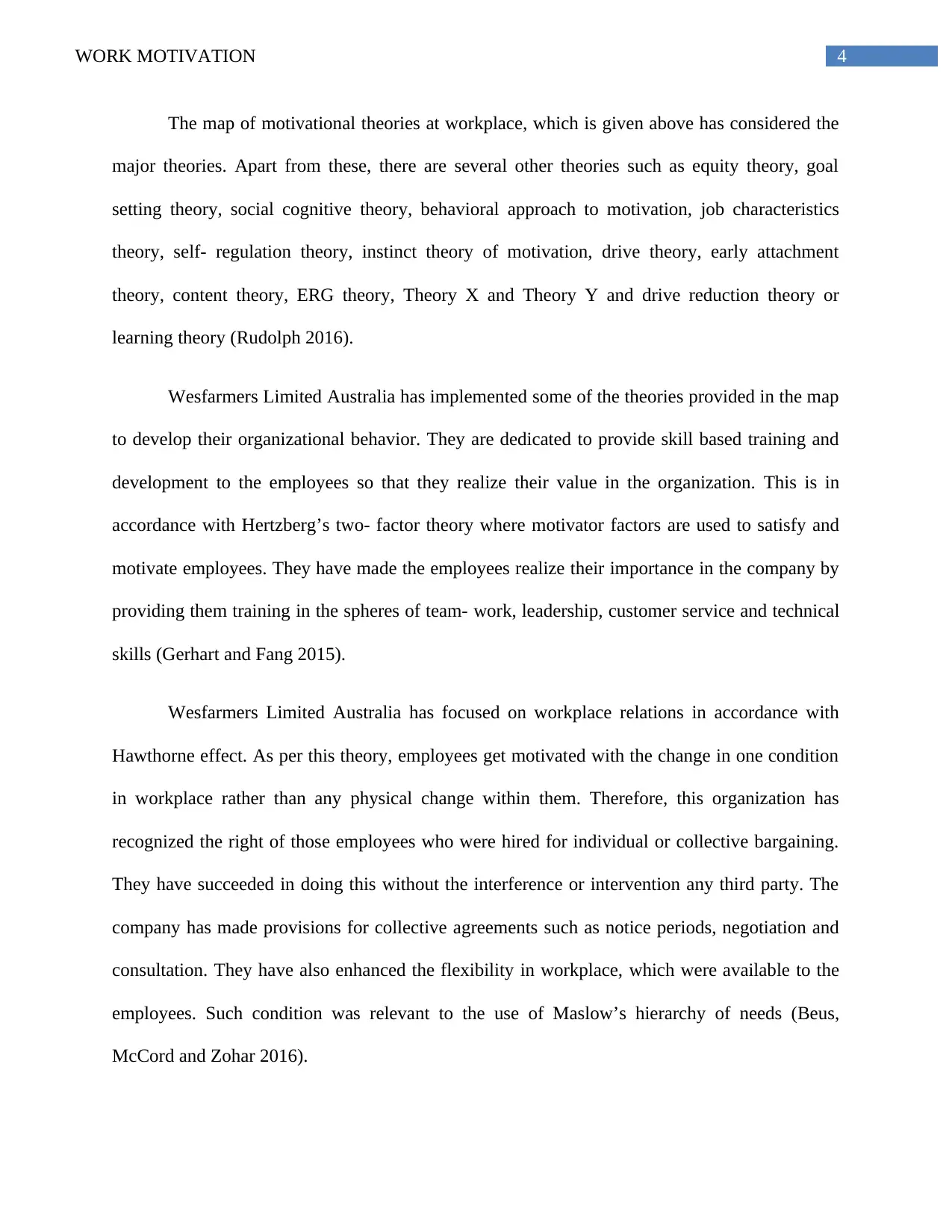
4WORK MOTIVATION
The map of motivational theories at workplace, which is given above has considered the
major theories. Apart from these, there are several other theories such as equity theory, goal
setting theory, social cognitive theory, behavioral approach to motivation, job characteristics
theory, self- regulation theory, instinct theory of motivation, drive theory, early attachment
theory, content theory, ERG theory, Theory X and Theory Y and drive reduction theory or
learning theory (Rudolph 2016).
Wesfarmers Limited Australia has implemented some of the theories provided in the map
to develop their organizational behavior. They are dedicated to provide skill based training and
development to the employees so that they realize their value in the organization. This is in
accordance with Hertzberg’s two- factor theory where motivator factors are used to satisfy and
motivate employees. They have made the employees realize their importance in the company by
providing them training in the spheres of team- work, leadership, customer service and technical
skills (Gerhart and Fang 2015).
Wesfarmers Limited Australia has focused on workplace relations in accordance with
Hawthorne effect. As per this theory, employees get motivated with the change in one condition
in workplace rather than any physical change within them. Therefore, this organization has
recognized the right of those employees who were hired for individual or collective bargaining.
They have succeeded in doing this without the interference or intervention any third party. The
company has made provisions for collective agreements such as notice periods, negotiation and
consultation. They have also enhanced the flexibility in workplace, which were available to the
employees. Such condition was relevant to the use of Maslow’s hierarchy of needs (Beus,
McCord and Zohar 2016).
The map of motivational theories at workplace, which is given above has considered the
major theories. Apart from these, there are several other theories such as equity theory, goal
setting theory, social cognitive theory, behavioral approach to motivation, job characteristics
theory, self- regulation theory, instinct theory of motivation, drive theory, early attachment
theory, content theory, ERG theory, Theory X and Theory Y and drive reduction theory or
learning theory (Rudolph 2016).
Wesfarmers Limited Australia has implemented some of the theories provided in the map
to develop their organizational behavior. They are dedicated to provide skill based training and
development to the employees so that they realize their value in the organization. This is in
accordance with Hertzberg’s two- factor theory where motivator factors are used to satisfy and
motivate employees. They have made the employees realize their importance in the company by
providing them training in the spheres of team- work, leadership, customer service and technical
skills (Gerhart and Fang 2015).
Wesfarmers Limited Australia has focused on workplace relations in accordance with
Hawthorne effect. As per this theory, employees get motivated with the change in one condition
in workplace rather than any physical change within them. Therefore, this organization has
recognized the right of those employees who were hired for individual or collective bargaining.
They have succeeded in doing this without the interference or intervention any third party. The
company has made provisions for collective agreements such as notice periods, negotiation and
consultation. They have also enhanced the flexibility in workplace, which were available to the
employees. Such condition was relevant to the use of Maslow’s hierarchy of needs (Beus,
McCord and Zohar 2016).

5WORK MOTIVATION
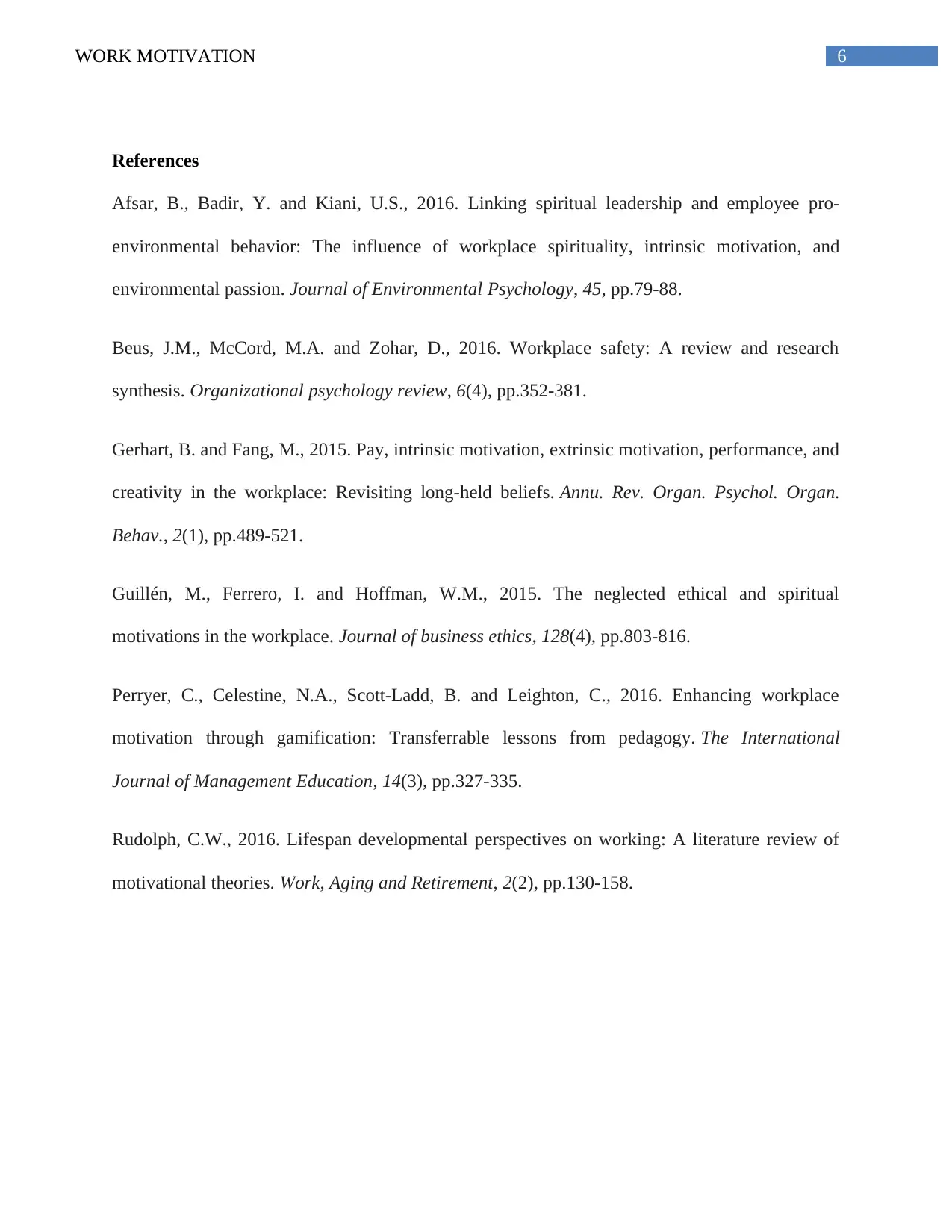
6WORK MOTIVATION
References
Afsar, B., Badir, Y. and Kiani, U.S., 2016. Linking spiritual leadership and employee pro-
environmental behavior: The influence of workplace spirituality, intrinsic motivation, and
environmental passion. Journal of Environmental Psychology, 45, pp.79-88.
Beus, J.M., McCord, M.A. and Zohar, D., 2016. Workplace safety: A review and research
synthesis. Organizational psychology review, 6(4), pp.352-381.
Gerhart, B. and Fang, M., 2015. Pay, intrinsic motivation, extrinsic motivation, performance, and
creativity in the workplace: Revisiting long-held beliefs. Annu. Rev. Organ. Psychol. Organ.
Behav., 2(1), pp.489-521.
Guillén, M., Ferrero, I. and Hoffman, W.M., 2015. The neglected ethical and spiritual
motivations in the workplace. Journal of business ethics, 128(4), pp.803-816.
Perryer, C., Celestine, N.A., Scott-Ladd, B. and Leighton, C., 2016. Enhancing workplace
motivation through gamification: Transferrable lessons from pedagogy. The International
Journal of Management Education, 14(3), pp.327-335.
Rudolph, C.W., 2016. Lifespan developmental perspectives on working: A literature review of
motivational theories. Work, Aging and Retirement, 2(2), pp.130-158.
References
Afsar, B., Badir, Y. and Kiani, U.S., 2016. Linking spiritual leadership and employee pro-
environmental behavior: The influence of workplace spirituality, intrinsic motivation, and
environmental passion. Journal of Environmental Psychology, 45, pp.79-88.
Beus, J.M., McCord, M.A. and Zohar, D., 2016. Workplace safety: A review and research
synthesis. Organizational psychology review, 6(4), pp.352-381.
Gerhart, B. and Fang, M., 2015. Pay, intrinsic motivation, extrinsic motivation, performance, and
creativity in the workplace: Revisiting long-held beliefs. Annu. Rev. Organ. Psychol. Organ.
Behav., 2(1), pp.489-521.
Guillén, M., Ferrero, I. and Hoffman, W.M., 2015. The neglected ethical and spiritual
motivations in the workplace. Journal of business ethics, 128(4), pp.803-816.
Perryer, C., Celestine, N.A., Scott-Ladd, B. and Leighton, C., 2016. Enhancing workplace
motivation through gamification: Transferrable lessons from pedagogy. The International
Journal of Management Education, 14(3), pp.327-335.
Rudolph, C.W., 2016. Lifespan developmental perspectives on working: A literature review of
motivational theories. Work, Aging and Retirement, 2(2), pp.130-158.
1 out of 7
Related Documents
Your All-in-One AI-Powered Toolkit for Academic Success.
+13062052269
info@desklib.com
Available 24*7 on WhatsApp / Email
![[object Object]](/_next/static/media/star-bottom.7253800d.svg)
Unlock your academic potential
© 2024 | Zucol Services PVT LTD | All rights reserved.





